ISDB
The Integrated Services Digital Broadcasting (ISDB; Japanese: 統合デジタル放送サービス, Tōgō dejitaru hōsō sābisu) is a Japanese standard for digital television (DTV) and digital radio used by the country's radio and television networks. ISDB supersedes both the NTSC-J analog television system and the previously used MUSE Hi-vision analog HDTV system in Japan as well as the NTSC, PAL-M, and PAL-N broadcast standards in South America and the Philippines. Digital Terrestrial Television Broadcasting (DTTB) services using ISDB-T started in Japan in December 2003 and Brazil in December 2007 as a trial. Since then, many countries have adopted ISDB over other digital broadcasting standards.
| List of digital television broadcast standards |
|---|
| DVB standards (countries) |
| ATSC standards (countries) |
|
| ISDB standards (countries) |
| DTMB standards (countries) |
| DMB standard (countries) |
|
| Codecs |
| Terrestial Frequency bands |
| Incentive | |
| Founded | 1981 |
| Headquarters | Japan |
Countries and territories using ISDB-T
Asia
America


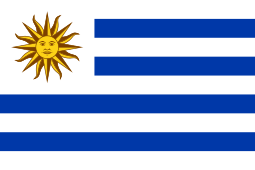



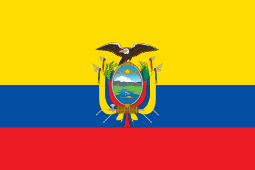
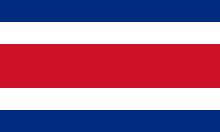
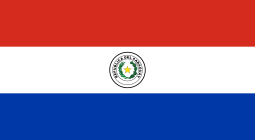
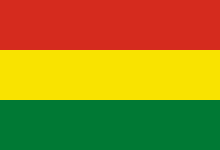
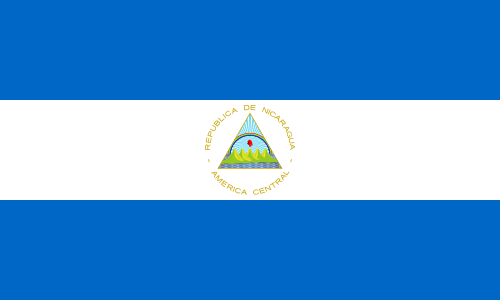
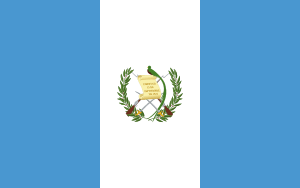
.svg.png)
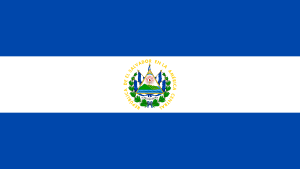
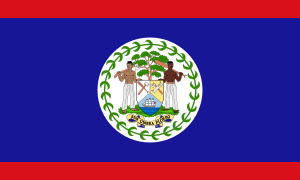
Introduction
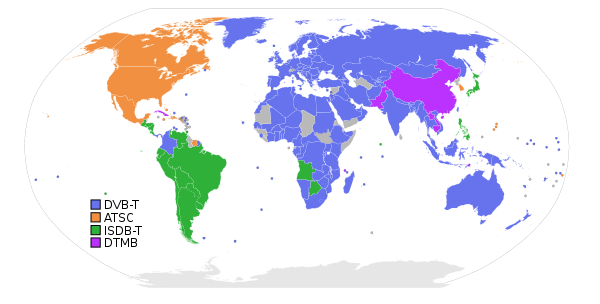
ISDB is maintained by the Japanese organization ARIB. The standards can be obtained for free at the Japanese organization DiBEG website and at ARIB.
The core standards of ISDB are ISDB-S (satellite television), ISDB-T (terrestrial), ISDB-C (cable) and 2.6 GHz band mobile broadcasting which are all based on MPEG-2, MPEG-4, or HEVC standard for multiplexing with transport stream structure and video and audio coding (MPEG-2, H.264, or HEVC) and are capable of UHD, high-definition television (HDTV) and standard-definition television. ISDB-T and ISDB-Tsb are for mobile reception in TV bands. 1seg is the name of an ISDB-T component that allows viewers to watch TV channels via cell phones, laptop computers, and vehicles.
The concept was named for its similarity to ISDN as both allow multiple channels of data to be transmitted together (a process called multiplexing). This broadcast standard is also much like another digital radio system, Eureka 147, which calls each group of stations on a transmitter an ensemble; this is very much like the multi-channel digital TV standard DVB-T. ISDB-T operates on unused TV channels, an approach that was taken by other countries for TV but never before for radio.
Transmission
The various flavors of ISDB differ mainly in the modulations used, due to the requirements of different frequency bands. The 12 GHz band ISDB-S uses PSK modulation, 2.6 GHz band digital sound broadcasting uses CDM, and ISDB-T (in VHF and/or UHF band) uses COFDM with PSK/QAM.
Interaction
Besides audio and video transmission, ISDB also defines data connections (Data broadcasting) with the internet as a return channel over several media (10Base-T/100Base-T, Telephone line modem, Mobile phone, Wireless LAN (IEEE 802.11), etc.) and with different protocols. This component is used, for example, for interactive interfaces like data broadcasting (ARIB STD-B24) and electronic program guides (EPG).
Interfaces and Encryption
The ISDB specification describes a lot of (network) interfaces, but most importantly, the Common Interface for Conditional Access System (CAS). While ISDB has examples of implementing various kinds of CAS systems, in Japan, a CAS system called "B-CAS" is used. ARIB STD-B25 defines the Common Scrambling Algorithm (CSA) system called MULTI2 required for (de-)scrambling television.
The ISDB CAS system in Japan is operated by a company named B-CAS; the CAS card is called B-CAS card. The Japanese ISDB signal is always encrypted by the B-CAS system even if it is a free television program. That is why it is commonly called "Pay per view system without charge". An interface for mobile reception is under consideration.
ISDB supports RMP (Rights management and protection). Since all digital television (DTV) systems carry digital data content, a DVD or high-definition (HD) recorder could easily copy content losslessly. Hollywood requested copy protection; this was the main reason for RMP being mandated. The content has three modes: "copy once", "copy free" and "copy never". In "copy once" mode, a program can be stored on a hard disk recorder, but cannot be further copied; only moved to another copy-protected media—and this move operation will mark the content "copy one generation", which is mandated to prevent further copying permanently. "Copy never" programs may only be timeshifted and cannot be permanently stored. In 2006,[18] the Japanese government is evaluating using the Digital Transmission Content Protection (DTCP) "Encryption plus Non-Assertion" mechanism to allow making multiple copies of digital content between compliant devices.[18]
Receiver
There are two types of ISDB receiver: Television and set-top box. The aspect ratio of an ISDB-receiving television set is 16:9; televisions fulfilling these specs are called Hi-Vision TV. There are four TV types: Cathode ray tube (CRT), plasma display panel (PDP), organic light-emitting diode (OLED) and liquid crystal display (LCD), with LCD being the most popular Hi-Vision TV on the Japanese market nowadays.
The LCD share, as measured by JEITA in November 2004, was about 60%. While PDP sets occupy the high-end market with units that are over 50 inches (1270 mm), PDP and CRT set shares are about 20% each. CRT sets are considered low end for Hi-Vision. An STB is sometimes referred to as a digital tuner.
Typical middle to high-end ISDB receivers marketed in Japan have several interfaces:
- F connectors for RF input.
- HDMI or D4 connector for HDTV a monitor in home cinema.
- Optical digital audio interface for an audio amplifier and speakers for 5.1 surround audio in a home cinema.
- IEEE 1394 (aka FireWire) interface for digital data recorders (like DVD recorders) in a home cinema.
- RCA video jack provides SDTV signal that is sampled down from the HDTV signal for analog CRT television sets or VCRs.
- RCA audio jacks provide stereo audio for analog CRT television sets or VCRs.
- S video is for VCRs or analog CRT television sets.
- 10BASE-T/100BASE-T and modular jack telephone line modem interfaces are for an internet connection.
- B-CAS card interface to de-scramble.
- IR interface jack for controlling a VHS or DVD player.
Copy-protection technology
All TV broadcasters in Japan are encrypted with Copy-Once, which allows users to record to a digital medium (such as a D-VHS, a DVD, or an HDD) but does not allow dubbing to another digital medium. On the other hand, the "Copy-Once" technology does not prohibit all types of dubbing. It is possible to dub to an analog medium (such as standard VHS), and if recorded to an HDD, it allows users to "Move" the contents to a D-VHS, but not copy. In contrast, 1seg digital broadcasts, which are for low-bandwidth mobile reception and occupy 1/13th of a digital channel, are transmitted "in the clear" and do not carry copy protection information.
Many users are also anxious about the recent news of severe protection in the future. There are modes in ISDB that do not allow the output of a signal from an Analog connector (such as D-connector, Component, Composite, or S-Video). There are already plans to restrict analog output (similar to Blu-ray and HD DVD) for "Copyright Protection" reasons, making all currently sold STB Tuners, LCD/Plasma TVs (without HDMI inputs), analog-output-only VHS and D-VHS systems, and DVD players, unusable. These more limiting copy protection technologies will all start after analog broadcasting ends (when there won't be any choice for viewers). Currently, no financial assistance schemes have been announced, forcing viewers without proper devices to buy new TVs or STB boxes that receive ISDB broadcasts. Though not clear, it is said that there are also plans to protect all programs with "Copy-Never".
The copy protection on ISDB broadcasts can be circumvented with the proper hardware and software.[19]
Brazilian standard ISDB-Tb does not implement this copy protection mechanism. For other countries, there are some examples of implementing a CAS system (such as Verimatrix) by the operators' choice.
B-CAS card
The B-CAS card is required to decode all broadcasts in Japan. These cards are included with every digital TV or tuner at no charge. To use this card, the end-user must agree to the statement written on the registration card. Although the card must be inserted to watch TV, if the end-user refuses to accept the terms/conditions contained within the statement, the user cannot watch digital broadcasts. Essentially, users are "forced" to agree with the statement. Though registration is not required, it is recommended to enjoy interactive programs. Unregistered B-CAS cards display a watermark in the corner of the screen, suggesting the user to register. However, many viewers worry about the leaking of personal information, and the power/rights the TV stations have to access personal information for almost every citizen in Japan. In case of loss or destruction, a new B-CAS card of the same number can be issued for a fee of 2,000 yen.[20]
Services
A typical Japanese broadcast service consists as follows:
- One HDTV or up to three SDTV services within one channel.
- Provides datacasting.
- Interactive services such as games or shopping, via telephone line or broadband internet.
- Equipped with an electronic program guide.
- Ability to send firmware patches for the TV/tuner over the air.
- During emergencies, the service utilizes Emergency Warning Broadcast system to quickly inform the public of various threats for the areas at risk.
There are examples providing more than 10 SDTV services with H.264 coding in some countries.
ISDB-S
History
Japan started digital broadcasting using the DVB-S standard by PerfecTV in October/1996, and DirecTV in December/1997, with communication satellites. Still, DVB-S did not satisfy the requirements of Japanese broadcasters, such as NHK, key commercial broadcasting stations like Nippon Television, TBS, Fuji Television, TV Asahi, TV Tokyo, and WOWOW (Movie-only Pay-TV broadcasting). Consequently, ARIB developed a new broadcast standard called ISDB-S. The requirements were HDTV capability, interactive services, network access and effective frequency utilization, and other technical requirements. The DVB-S standard allows the transmission of a bitstream of roughly 34 Mbit/s with a satellite transponder, which means the transponder can send one HDTV channel. Unfortunately, the NHK broadcasting satellite had only four vacant transponders, which led ARIB and NHK to work on ISDB-S: the new standard could transmit at 51 Mbit/s with a single transponder, which means that ISDB-S is 1.5 times more efficient than DVB-S and that one transponder can transmit two HDTV channels, along with other independent audio and data. Digital satellite broadcasting (BS digital) was started by NHK and followed commercial broadcasting stations on 1 December 2000. Today, SKY PerfecTV! (the successor of Skyport TV and Sky D), CS burn, Platone, EP, DirecTV, J Sky B, and PerfecTV!, adopted the ISDB-S system for use on the 110-degree (east longitude) wide-band communication satellite.
Technical specification
This table shows the summary of ISDB-S (satellite digital broadcasting).
| Transmission channel coding | Modulation | TC8PSK, QPSK, BPSK (Hierarchical transmission) | |
|---|---|---|---|
| Error correction coding | Inner coding | Trellis [TC8PSK] and Convolution | |
| Outer coding | RS (204,188) | ||
| TMCC | Convolution coding+RS | ||
| Time domain multiplexing | TMCC | ||
| Conditional Access | Multi-2 | ||
| Data broadcasting | ARIB STD-B24 (BML, ECMA script) | ||
| Service information | ARIB STD-B10 | ||
| Multiplexing | MPEG-2 Systems | ||
| Audio coding | MPEG-2 Audio (AAC) | ||
| Video coding | MPEG-2 Video | ||
Channel
Frequency and channel specification of Japanese Satellites using ISDB-S
| Method | BS digital broadcasting | Wide band CS digital broadcasting |
|---|---|---|
| Frequency band | 11.7 to 12.2 GHz | 12.2 to 12.75 GHz |
| Transmission bit rate | 51 Mbit/s (TC8PSK) | 40 Mbit/s (QPSK) |
| Transmission band width | 34.5 MHz* | 34.5 MHz |
| *Compatible with 27 MHz band satellite transponder for analog FM broadcasting. | ||
ISDB-S3
New satellite version supporting 4K, 8K, HDR, HFR, and 22.2 audio.[21]
ISDB-C
ISDB-C is cable digital broadcasting specification. The technical specification J.83/C is developed by JCTEA. ISDB-C is identical to DVB-C but has a different channel bandwidth of 6 MHz (instead of 8 MHz) and roll-off factor.[22]
ISDB-T
History
HDTV was invented at NHK Science & Technology Research Laboratories (Japan Broadcasting Corporation's Science & Technical Research Laboratories). The research for HDTV started as early as the 1960s, though a standard was proposed to the ITU-R (CCIR) only in 1973.[23]
By the 1980s, a high definition television camera, cathode-ray tube, videotape recorder, and editing equipment, among others, had been developed. In 1982 NHK developed MUSE (Multiple sub-Nyquist sampling encoding), the first HDTV video compression and transmission system. MUSE used digital video compression, but for transmission frequency modulation was used after a digital-to-analog converter converted the digital signal.
In 1987, NHK demonstrated MUSE in Washington D.C. as well as NAB. The demonstration made a great impression in the U.S., leading to the development of the ATSC terrestrial DTV system. Europe also developed a DTV system called DVB. Japan began R&D of a completely digital system in the 1980s that led to ISDB. Japan began terrestrial digital broadcasting, using ISDB-T standard by NHK and commercial broadcasting stations, on 1 December 2003.
Features
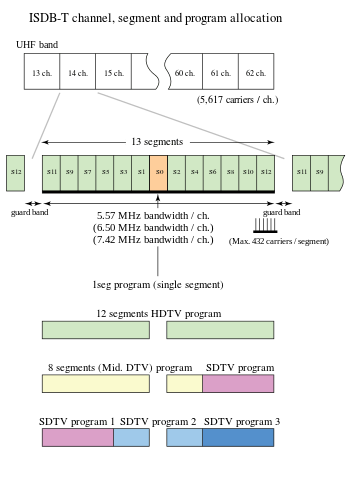
ISDB-T is characterized by the following features:
- ISDB-T (Integrated Services Digital Broadcasting-Terrestrial) in Japan use UHF 470 MHz-770 MHz, bandwidth of 300 MHz, allocate 50 channels, namely ch.13-ch.62, each channel is 6 MHz width (actually 5.572 MHz effective bandwidth and 430 kHz guard band between channels). These channels are called "physical channel(物理チャンネル)". For other countries, US channel table or European channel table are used.
- For channel tables with 6 MHz width, ISDB-T single channel bandwidths 5.572 MHz has number of carriers 5,617 with interval of 0.99206 kHz. For 7 MHz channel, channel bandwidth is 6.50 MHz; for 8 MHz 7.42 MHz.
- ISDB-T allows to accommodate any combination of HDTV (roughly 8Mbit/s in H.264) and SDTV (roughly 2Mbit/s in H.264) within the given bitrate determined by the transmission parameters such as bandwidth, code-rate, guard interval, etc. Typically, among the 13 segments, the center segment is used for 1seg with QPSK modulation and the remaining 12 segments for the HDTV or SDTV payloads for 64QAM modulation. The bitstream of the 12 segments are combined into one transport stream, within which any combination of programs can be carried based on the MPEG-2 transport stream definition.
- ISDB-T transmits a HDTV channel and a mobile TV channel 1seg within one channel. 1seg is a mobile terrestrial digital audio/video broadcasting service in Japan. Although 1seg is designed for mobile usage, reception is sometimes problematic in moving vehicles. Because of reception on high speed vehicle, UHF transmission is shaded by buildings and hills frequently, but reported well receiving in Shinkansen as far as run in flat or rural area.
- ISDB-T provides interactive services with data broadcasting. Such as Electronic Program Guides. ISDB-T supports internet access as a return channel that works to support the data broadcasting. Internet access is also provided on mobile phones.
- ISDB-T provides Single Frequency Network (SFN) and on-channel repeater technology. SFN makes efficient utilization of the frequency resource (spectrum). For example, the Kanto area (greater Tokyo area including most part of Tokyo prefecture and some part of Chiba, Ibaragi, Tochigi, Saitama and Kanagawa prefecture) are covered with SFN with roughly 10 million population coverage.
- ISDB-T can be received indoors with a simple indoor antenna.
- ISDB-T provides robustness to multipath interference ("ghosting"), co-channel analog television interference, and electromagnetic interferences that come from motor vehicles and power lines in urban environments.
- ISDB-T is claimed to allow HDTV to be received on moving vehicles at over 100 km/h; DVB-T can only receive SDTV on moving vehicles, and it is claimed that ATSC can not be received on moving vehicles at all (however, in early 2007 there were reports of successful reception of ATSC on laptops using USB tuners in moving vehicles).
Adoption
ISDB-T was adopted for commercial transmissions in Japan in December 2003. It currently comprises a market of about 100 million television sets. ISDB-T had 10 million subscribers by the end of April 2005. Along with the wide use of ISDB-T, the price of receivers is getting low. The price of ISDB-T STB in the lower end of the market is ¥19800 as of 19 April 2006.[24] By November 2007 only a few older, low-end STB models could be found in the Japanese market (average price U$180), showing a tendency towards replacement by mid to high-end equipment like PVRs and TV sets with inbuilt tuners. In November 2009, a retail chain AEON introduced STB in 40 USD,[25] followed by variety of low-cost tuners. The Dibeg web page confirms this tendency by showing low significance of the digital tuner STB market in Japan.[26]
Brazil, which currently uses an analogue TV system (PAL-M) that slightly differs from any other countries, has chosen ISDB-T as a base for its DTV format, calling it ISDB-Tb or internally SBTVD (Sistema Brasileiro de Televisão Digital-Terrestre). The Japanese DiBEG group incorporated the advancements made by Brazil -MPEG4 video codec instead of ISDB-T's MPEG2 and a powerful interaction middleware called Ginga- and has renamed the standard to "ISDB-T International".[27] Other than Argentina, Brazil, Peru, Chile and Ecuador[28] which have already selected ISDB-Tb, there are other South American countries, mainly from Mercosur, such as Venezuela,[29] that are considering ISDB-Tb, which could provide economies of scale and common market benefits from the regional South American manufacturing instead of importing ready-made STBs as is the case with the other standards. Also, it has been confirmed with extensive tests realized by Brazilian Association of Radio and Television Broadcasters (ABERT), Brazilian Television Engineering Society (SET) and Universidade Presbiteriana Mackenzie the insufficient quality for indoor reception presented by ATSC and, between DVB-T and ISDB-T, the latter presented superior performance in indoor reception and flexibility to access digital services and TV programs through non-mobile, mobile or portable receivers with impressive quality.[30]
The ABERT–SET group in Brazil did system comparison tests of DTV under the supervision of the CPqD foundation. The comparison tests were done under the direction of a work group of SET and ABERT. The ABERT/SET group selected ISDB-T as the best choice in digital broadcasting modulation systems among ATSC, DVB-T and ISDB-T. Another study found that ISDB-T and DVB-T performed similarly, and that both were outperformed by DVB-T2.[31]
ISDB-T was singled out as the most flexible of all for meeting the needs of mobility and portability. It is most efficient for mobile and portable reception. On June 29, 2006, Brazil announced ISDB-T-based SBTVD as the chosen standard for digital TV transmissions, to be fully implemented by 2016. By November 2007 (one month prior DTTV launch), a few suppliers started to announce zapper STBs of the new Nippon-Brazilian SBTVD-T standard, at that time without interactivity.
The implementation rollout in Brazil is proceeding successfully although some voice like Philips' say[32] that its implementation could be faster. It terms of broadcasting, the implementation plan seems to be on target. In only eight months since the start, the digital signal is present in four state capitals and by the end of 2008 another three capitals will receive the signal.
Adoption by country
This lists the other countries who adopted the ISDB-T standard, chronologically arranged.
- On April 23, 2009, Peru announced its decision to adopt ISDB-T as the digital terrestrial television standard. This decision was taken on the basis of the recommendations by the Multi-sectional Commission to assess the most appropriate standard for the country.
- On August 28, 2009, Argentina officially adopted the ISDB-T system[33] calling it internally SATVD-T (Sistema Argentino de Televisión Digital - Terrestre).[34]
- On September 14, 2009, Chile announced it was adopting the ISDB-T standard because it adapts better to the geographical makeup of the country, while allowing signal reception in cell phones, high-definition content delivery and a wider variety of channels.[28]
- On October 6, 2009, Venezuela officially adopted the ISDB-T standard.[35][36]
- On March 26, 2010, Ecuador announced its decision to adopt ISDB-T standard. This decision was taken on the basis of the recommendations by the Superintendent of Telecommunications.[37]
- On April 29, 2010, Costa Rica officially announced the adoption of ISDB-Tb standard based upon a commission in charge of analyzing which protocol to accept.[38]
- On June 1, 2010, Paraguay officially adopted ISDB-T International, via a presidential decree #4483.[39]
- On June 11, 2010, the Philippines (NTC) officially adopted the ISDB-T standard.[40]
- On July 6, 2010, Bolivia announced its decision to adopt ISDB-T standard as well.
- On December 27, 2010, the Uruguayan Government adopts the ISDB-T standard.,[41] voiding a previous 2007 decree which adopted the European DVB system.
- On November 15, 2011, the Maldivian Government adopts the ISDB-T standard.[4] As the first country in the region that use European channel table and 1 channel bandwidth is 8 MHz.
- On February 26, 2013, the Botswana government adopts the ISDB-T standard. As the one of the first country within the SADC region and even the first country within the continent of Africa as a whole.
- On September 12, 2013, Honduras adopted the ISDB-T standard.
- On May 20, 2014, Government of Sri Lanka officially announced its decision to adopt ISDB-T standard,[42] and on September 7, 2014 Japanese Prime Minister Shinzo Abe signed an agreement with Sri Lankan President Mahinda Rajapakse for constructing infrastructure such as ISDB-T networks with a view to smooth conversion to ISDB-T, and cooperating in the field of content and developing human resources.
- On January 23, 2017, El Salvador adopted the ISDB-T standard.
- On March 20, 2019, Angola adopted the ISDB-T standard.
Technical specification
Segment structure
ARIB has developed a segment structure called BST-OFDM (see figure). ISDB-T divides the frequency band of one channel into thirteen segments. The broadcaster can select which combination of segments to use; this choice of segment structure allows for service flexibility. For example, ISDB-T can transmit both LDTV and HDTV using one TV channel or change to 3 SDTV, a switch that can be performed at any time. ISDB-T can also change the modulation scheme at the same time.
| s11 | s 9 | s 7 | s 5 | s 3 | s 1 | s 0 | s 2 | s 4 | s 6 | s 8 | s10 | s12 |
The above figure shows the spectrum of 13 segments structure of ISDB-T.
(s0 is generally used for 1seg, s1-s12 are used for one HDTV or three SDTVs)
Summary of ISDB-T
| Transmission channel coding |
Modulation | 64QAM-OFDM, 16QAM-OFDM, QPSK-OFDM, DQPSK-OFDM (Hierarchical transmission) | |
|---|---|---|---|
| Error correction coding | Data: Inner coding: Convolutional 7/8,5/6,3/4,2/3,1/2 Outer coding: Reed-Solomon(204,188) |
TMCC: Shortened code (184,102) of Difference Cyclic Code (273,191) | |
| Guard interval | 1/32,1/16,1/8,1/4 | ||
| Interleaving | Time, Frequency, bit, byte | ||
| Frequency domain multiplexing | BST-OFDM (Segmented structure OFDM) | ||
| Conditional Access | Multi-2 | ||
| Data broadcasting | ARIB STD-B24 (BML, ECMA script) | ||
| Service information | ARIB STD-B10 | ||
| Multiplexing | MPEG-2 Systems | ||
| Audio coding | MPEG-2 Audio (AAC) | ||
| Video coding | MPEG-2 Video | MPEG-4 AVC /H.264* | |
- H.264 Baseline profile is used in one segment (1seg) broadcasting for portables and Mobile phone.
- H.264 High-profile is used in ISDB-Tb to high definition broadcasts.
Channel
Specification of Japanese terrestrial digital broadcasting using ISDB-T.
| Method | Terrestrial digital broadcasting |
|---|---|
| Frequency band | VHF/UHF, super high band |
| Transmission bit rate | 23 Mbit/s(64QAM) |
| Transmission band width | 5.6 MHz* |
ISDB-Tsb
ISDB-Tsb is the terrestrial digital sound broadcasting specification. The technical specification is the same as ISDB-T. ISDB-Tsb supports the coded transmission of OFDM siginals.
ISDB-Tmm
ISDB-Tmm (Terrestrial mobile multi-media) utilised suitable number of segments by station with video coding MPEG-4 AVC/H.264. With multiple channels, ISDB-Tmm served dedicated channels such as sport, movie, music channels and others with CD quality sound, allowing for better broadcast quality as compared to 1seg. This service used the VHF band, 207.5–222 MHz which began to be utilised after Japan's switchover to digital television in July 2011.
Japan's Ministry of Internal Affairs and Communications licensed to NTT Docomo subsidiary mmbi, Inc. for ISDB-Tmm method on September 9, 2010.[43][44][45] The MediaFLO method offered with KDDI was not licensed.[46]
The ISDB-Tmm broadcasting service by mmbi, Inc. is named モバキャス (pronounced mobakyasu), literally short form of mobile casting on July 14, 2011, and had been branded as NOTTV since October 4, 2011. The Minister of Internal Affairs and Communications approved the start of operations of NOTTV on October 13, 2011.[47] Planning the service with monthly subscription fee of 420 yen for south Kanto Plain, Aichi, Osaka, Kyoto and some other prefectures from April 1, 2012. The deployment plan was to cover approximately 73% of households by the end of 2012, approximately 91% by the end of 2014, and 125 stations or repeaters to be installed in 2016 to cover cities nationwide.[48][49] Android smartphones and tablets with ISDB-Tmm receiving capability were also sold mainly by NTT DoCoMo, although a separate tuner (TV BoX manufactured by Huawei; or StationTV manufactured by Pixela) could be purchased for iPhones and iPads as well as Android smartphones and tablets sold by au by KDDI and SoftBank Mobile to receive ISDB-Tmm broadcasts.
Due to the continued unprofitability of NOTTV, mmbi, Inc. shut down the service on June 30, 2016.[50]
2.6 GHz Mobile satellite digital audio/video broadcasting
MobaHo! is the name of the services that uses the Mobile satellite digital audio broadcasting specifications. MobaHo! started its service on 20 October 2004. Ended on 31 March 2009
Future
A new terrestrial version should be proposed in 2020 and approved in 2021.
It should support 4K, 8K, HDR, HFR, and immersive audio.[51]
It has been suggested to use VVC video compression.
Standards
ARIB and JCTEA developed the following standards. Some part of standards are located on the pages of ITU-R and ITU-T.
| Channel | Communication Satellite television |
Broadcasting Communication Satellite television |
Terrestrial television | Satellite Sound | Terrestrial Sound | Cable television |
|---|---|---|---|---|---|---|
| Nickname | - | ISDB-S | ISDB-T | 2.6 GHz mobile broadcasting | ISDB-Tsb | 64QAM, Trans-modulation (ISDB-C) |
| Transmission | DVB-S | ARIB STD-B20 | ARIB STD-B31 | ARIB STD-B41 | ARIB STD-B29 | - |
| - | ITU-R BO.1408 | ITU-R BT.1306-1 | - | ITU-R BS.1114 | ITU-T J.83 Annex C, J.183 | |
| Receiver | ARIB STD-B16 | ARIB STD-B21 | ARIB STD-B42 | ARIB STD-B30 | JCTEA STD-004, STD-007 | |
| Server type broadcasting | - | ARIB STD-B38 | - | |||
| Conditional access | - | ARIB STD-B25 (Multi-2) | JCTEA STD-001 | |||
| Service information | - | ARIB STD-B10 | JCTEA STD-003 | |||
| Data broadcasting | - | ARIB STD-B24 (BML), ARIB STD-B23 (EE or MHP like) | - | |||
| Video/Audio compression and multiplexing | MPEG-2 | ARIB STD-B32 (MPEG) | - | |||
| Technical report | - | ARIB TR-B13 | ARIB TR-B14 | - | - | - |
Table of terrestrial HDTV transmission systems
| Systems | ATSC 8-VSB | DVB COFDM | ISDB BST-COFDM |
|---|---|---|---|
| Source coding | |||
| Video | Main profile syntax of ISO/IEC 13818-2 (MPEG-2 - video) | ||
| Audio | ATSC Standard A/52 (Dolby AC-3) | ISO/IEC 13818-2 (MPEG-2 – layer II audio) and Dolby AC-3 | ISO/IEC 13818-7 (MPEG-2 – AAC audio) |
| Transmission system | |||
| Channel coding | - | ||
| Outer coding | R-S (207, 187, t = 10) | R-S (204, 188, t = 8) | |
| Outer interleaver | 52 R-S block interleaver | 12 R-S block interleaver | |
| Inner coding | Rate 2/3 trellis code | Punctured convolution code: Rate 1/2, 2/3,3/4, 5/6, 7/8 Constraint length = 7, Polynomials (octal) = 171, 133 | |
| Inner interleaver | 12 to 1 trellis code interleaver | Bit-wise interleaving and frequency interleaving | Bit-wise interleaving, frequency interleaving and selectable time interleaving |
| Data randomization | 16-bit PRBS | ||
| Modulation | 8-VSB and 16-VSB | COFDM QPSK, 16QAM and 64QAM Hierarchical modulation: multi-resolution constellation (16QAM and 64 QAM) Guard interval: 1/32, 1/16, 1/8 & 1/4 of OFDM symbol 2 modes: 2k and 8k FFT |
BST-COFDM with 13 frequency segments DQPSK, QPSK, 16QAM and 64QAM Hierarchical modulation: choice of three different modulations on each segment Guard interval: 1/32, 1/16, 1/8 & 1/4 of OFDM symbol 3 modes: 2k, 4k and 8k FFT |
See also
General category
- DiBEG - The Digital Broadcasting Experts Group
- Digital television
- Digital terrestrial television
- Digital audio broadcasting
- DMB
- 1seg
- B-CAS
- Data broadcasting
- SDTV, EDTV, HDTV
- ISDB-T International (SBTVD) - Brazilian Digital Television System based on ISDB-T
- Tokyo Skytree - ISDB-T broadcasting for Kanto Plain
Transmission technology
- ATSC Standards - Advanced Television Systems Committee Standard
- DMB-T - Digital Multimedia Broadcast-Terrestrial
- DVB-T - Digital Video Broadcasting-Terrestrial
- MPEG
- Single frequency network (SFN), multi-frequency network (MFN)
References
- "Archived copy". Archived from the original on 2012-03-27. Retrieved 2011-11-17.CS1 maint: archived copy as title (link)
- https://dtvpilipinas.blogspot.com/2011/08/news5-interaksyon-were-turning-japanese.html
- モルディブ共和国政府による同国国営放送の地デジ日本方式採用決定、日・モルディブ共同声明を公表 [Republic of Maldives decided to adopt ISDB-T, Japan-Maldives issued a joint statement] (in Japanese). Tokyo: Ministry of Internal Affairs and Communications. 2011-10-19. Retrieved 2011-10-19.
- "Archived copy". Archived from the original on 2012-01-11. Retrieved 2011-10-23.CS1 maint: archived copy as title (link)
- "Archived copy". Archived from the original on 2014-09-08. Retrieved 2014-09-08.CS1 maint: archived copy as title (link)
- http://www.soumu.go.jp/main_sosiki/joho_tsusin/eng/Releases/Telecommunications/140520_04.html
- "DTT: Uruguay Regains Common Sense". Montevideo, Uruguay: ttv medianews. 2010-12-28. Archived from the original on 2011-07-17. Retrieved 2010-12-29.
- Gobierno se decidió por la norma japonesa
- "Costa Rica held its first broadcast on DTT ISDB-Tb". Panorama Audiovisual. 2012-03-21. Archived from the original on 2012-03-30. Retrieved 2012-03-22.
- Ministry of Internal Affairs and Communications (2010-07-05). ボリビア多民族国における地上デジタルテレビ放送日本方式採用の決定 [The decision to adopt Japanese DTT system at Plurinational State of Bolivia] (in Japanese). Tokyo, Japan. Retrieved 2010-07-07.
- "Archived copy". Archived from the original on 2011-09-29. Retrieved 2010-07-07.CS1 maint: archived copy as title (link)
- TeleSemana (2010-08-10). "Nicaragua opta por la noma brasileña-japonesa para TV digital". Archived from the original on 2011-07-16.
- "Botswana adopts ISDB-T". Botswana Daily News. Gaborone: Daily News. 2013-02-27. Archived from the original on 2013-06-21. Retrieved 2013-03-18.
- "Decision of Adoption of Japanese System for Digital Terrestrial Television Broadcasting in the Republic of Botswana". Tokyo: Ministry of Internal Affairs and Communications. 2013-02-27. Retrieved 2013-03-18.
- ボツワナ共和国における地上デジタルテレビ放送日本方式採用の決定-アフリカで初となる日本方式採用の決定 [Botswana decided to adopt Japanese DTT (ISDB-T) system, first ISDB-T adopt in African countries] (in Japanese). Tokyo: Ministry of Internal Affairs and Communications, Japan. 2013-02-27. Retrieved 2013-03-18.
- "Adoption of Japanese Digital Terrestrial TV Broadcasting System (ISDB-T System) in the Republic of Angola". Ministry of Internal Affairs and Communications. 2019-05-25. Retrieved 2019-08-08.
- JEITA、地デジのコンテンツ保護策として暗号方式 EPN を提案:ニュース - CNET Japan
- Software B-CAS Conditional Access Module with MULTI2 decoder
- "B-CAS*各種手続き*" (in Japanese). Retrieved 2007-09-01.
- https://www.arib.or.jp/english/std_tr/broadcasting/std-b63.html
- https://www.dvb.org/news/dvb_c2-in-japan
- "ArchivalWare >>Login". digitalcollections.library.cmu.edu. Retrieved 2018-09-14.
- (in Japanese) uniden Archived 2007-07-09 at the Wayback Machine
- http://av.watch.impress.co.jp/docs/news/20090904_313051.html
- "Archived copy". Archived from the original on 2007-11-14. Retrieved 2007-11-22.CS1 maint: archived copy as title (link)
- "Archived copy". Archived from the original on 2009-08-09. Retrieved 2009-08-30.CS1 maint: archived copy as title (link)
- "Archived copy". Archived from the original on 2009-09-22. Retrieved 2009-09-14.CS1 maint: archived copy as title (link)
- http://www.telesintese.ig.com.br/index.php?option=content&task=view&id=13284%5B%5D
- "Archived copy". Archived from the original on 2011-09-28. Retrieved 2011-09-28.CS1 maint: archived copy as title (link)
- Julian Clover DVB-T far superior to ISDB, DVB-T2 beats them both, in broadbandtvnews November 2, 2010
- http://www.boletinoficial.gov.ar/DisplayPdf.aspx?s=01&f=20090828
- http://www.boletinoficial.gov.ar/DisplayPdf.aspx?f=20090901&s=01&pd=3&pa=4
- "Archived copy". Archived from the original on 2011-08-09. Retrieved 2010-06-25.CS1 maint: archived copy as title (link)
- "Archived copy". Archived from the original on 2011-08-09. Retrieved 2010-06-25.CS1 maint: archived copy as title (link)
- Ecuador adopta estándar japonés para televisión digital
- "Archived copy". Archived from the original on 2012-02-06. Retrieved 2011-12-30.CS1 maint: archived copy as title (link)
- Decreto presidencial 4483 de Paraguay
- "NTC Philippines". Archived from the original (PDF) on 2015-11-05. Retrieved 2015-05-30.
- Uruguayan government news (in spanish) Archived 2011-03-18 at the Wayback Machine
- Ministry of Internal Affairs and Communications Japan
- "Japan regulators favor ISDB-Tmm, not MediaFLO, for mobile TV". FierceWireless. 2010-09-08. Archived from the original on 2010-09-11. Retrieved 2010-09-12.
- "Japan chooses ISDB-Tmm over MediaFLO for new mobile TV network, KDDI pouts". Engadget. 2010-09-09. Archived from the original on 2010-09-11. Retrieved 2010-09-12.
- "207.5 MHz以上222 MHz以下の周波数を使用する特定基地局の開設計画の認定" [The licence approval of the plan to use specific broadcasting station for 207.5–222 MHz band usage] (in Japanese). Tokyo: Ministry of Internal Affairs and Communications. 2010-09-09. Retrieved 2010-09-12.
- "MediaFLO陣営、携帯次世代放送の認定結果に「極めて残念」" ["Too much disappointed" for approval of next generation mobile broadcasting — MediaFLO team] (in Japanese). Tokyo: Impress Watch. 2010-09-10. Retrieved 2010-09-12.
- "スマートフォン向け新放送局名称を「NOTTV(ノッティーヴィー)」に決定" [Decided new broadsacsting station is named to be NOTTV for Smartphone] (in Japanese). Tokyo: mmbi. 2011-10-04. Archived from the original on 2011-10-07. Retrieved 2011-10-11.
- "サービス名は「モバキャス」、mmbiがマルチメディア放送の具体像を説明" [Service is named モバキャス™ (Mobakyasu), mmbi, Inc explained concrete form of multimedia broadcasting] (in Japanese). 2011-07-14. Retrieved 2011-09-11.
- Japan appoints sole operator for mobile media, Rapid TV News, 2010-12-01.
- "「テレビと呼ぶには、面白すぎる」NOTTV、4年超でサービス終了". ITmedia ビジネスオンライン (in Japanese). June 30, 2016.
- https://www.itu.int/en/ITU-R/terrestrial/broadcast/Americas/Documents/Presentations_Panama/ISDB-T.pdf
External links
- Welcome to ISDB-T Official Web Site! Digital Broadcasting Experts Group (DiBEG)
- ISDB-T International Web Site!
- Outline of the Specification for ISDBNHK
- The ISDB-T SystemITU (link is down, 2012/10/28)
- Comparison Test Results in Brazil, Clear Superiority of the ISDB-T systemNHK
- Digital Television Laboratory and Field Test Results - BrazilITU
- ISDB-T: Japanese Digital Terrestrial Television Broadcasting (DTTB), (PDF) Asian Institute of Technology
- Final report of the Digital Terrestrial Television Peruvian Commission (In Spanish)
- Digital Broadcasting, the Launching by Country Digital Broadcasting Experts Group (DiBEG)
- ISDB-C - Cable Television Transmission for Digital Broadcasting in JapanNHK
- ISDB-S - Satellite Transmission System for Advanced Multimedia Services Provided by Integrated Services Digital BroadcastingNHK
- The Association for Promotion of Digital Broadcasting (Dpa)
- ISDB-T - Digital Terrestrial Television/Sound/Data Broadcasting in JapanNHK
- Switching On to ISDB-T Digital Highlighting Japan September 2010 (Public Relations Office Government of Japan)
- ISDB-Tmm